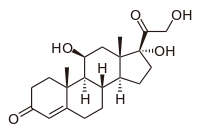
Photo from wikipedia
Glucocorticoids are widely used to suppress inflammation or the immune system. High doses and long-term use of glucocorticoids lead to an important and common iatrogenic complication, glucocorticoid-induced osteoporosis, in a… Click to show full abstract
Glucocorticoids are widely used to suppress inflammation or the immune system. High doses and long-term use of glucocorticoids lead to an important and common iatrogenic complication, glucocorticoid-induced osteoporosis, in a substantial proportion of patients. Glucocorticoids mainly increase bone resorption during the initial phase (the first year of treatment) by enhancing the differentiation and maturation of osteoclasts. Glucocorticoids also inhibit osteoblastogenesis and promote apoptosis of osteoblasts and osteocytes, resulting in decreased bone formation during long-term use. Several indirect effects of glucocorticoids on bone metabolism, such as suppression of production of insulin-like growth factor 1 or growth hormone, are involved in the pathogenesis of glucocorticoid-induced osteoporosis. Fracture risk assessment for all patients with long-term use of oral glucocorticoids is required. Non-pharmacological interventions to manage the risk of fracture should be prescribed to all patients, while pharmacological management is reserved for patients who have increased fracture risk. Various treatment options can be used, ranging from bisphosphonates to denosumab, as well as teriparatide. Finally, appropriate monitoring during treatment is also important. High doses and long-term use of glucocorticoids lead to an important and common iatrogenic complication, glucocorticoid-induced osteoporosis. This Review outlines our current understanding of the pathogenesis of glucocorticoid-induced osteoporosis and discusses treatment options. Glucocorticoid-induced osteoporosis is the most common cause of secondary osteoporosis and is an iatrogenic disease; the main pathogenesis in the long term is a reduction in bone formation. Fracture risk is correlated with the dose and duration of glucocorticoid administration, and seems to decrease rapidly on discontinuation; the underlying disease requiring glucocorticoid therapy often contributes to bone loss. Evaluation of fracture risk, using tools such as FRAX, is recommended in all patients treated with glucocorticoids, preferably around the time of treatment initiation. Non-pharmacological management (such as nutrition and exercise) should be advocated in all patients receiving long-term glucocorticoid treatment. Using the minimally effective dose and duration of glucocorticoids with steroid-sparing drugs should be considered where possible. Pharmacological anti-osteoporotic treatment is recommended in patients at high risk of fracture; anti-resorptives are the primary option but anabolic therapy might also be considered.
Journal Title: Nature Reviews Endocrinology
Year Published: 2020
Link to full text (if available)
Share on Social Media: Sign Up to like & get
recommendations!